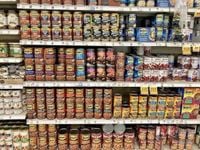Across the United States, sweeping changes to the Supplemental Nutrition Assistance Program (SNAP) are rippling through communities, leaving families, food pantries, and state agencies scrambling to adapt. The new rules, which began taking effect in early September 2025, tighten eligibility requirements and shift significant administrative costs from the federal government to the states. For millions who rely on SNAP to put food on the table, the stakes couldn’t be higher.
According to a report from Capital & Main published on September 8, 2025, concerns about health and nutrition in school lunches have become entangled in a broader conversation about social inequality and public policy. The article highlights how shifts in federal priorities are filtering down to everyday realities for families, especially as government policy changes reshape the safety net for the most vulnerable. While the promise of healthier children through improved school lunches remains a talking point, the real-world context is one of mounting challenges for those already struggling to make ends meet.
The most dramatic changes stem from the federal spending plan signed into law on July 4, 2025—a bill widely known as the “big, beautiful bill” under the Trump administration. As reported by 25News Now, this legislation slashed approximately $300 billion from SNAP funding nationwide. The impact is immediate and far-reaching: adults up to 64 years old with no dependents must now show proof of work or participation in job training for at least 20 hours a week to qualify for SNAP. Previously, these requirements only applied to those up to age 54, and parents were exempt if their children were under 18. Now, that exemption only applies if children are under seven, and in some states, under 14.
Children aged 14 to 18 are no longer considered dependents for SNAP work requirement purposes, a change that has left many families reeling. States, meanwhile, are shouldering a greater share of the burden. Where the federal government once covered half of SNAP’s administrative costs, states like Illinois and Florida must now pay 75%. The Illinois Department of Human Services estimates this will cost state taxpayers an additional $80 million, on top of $20 million needed to hire over 100 new staff to process the more complex eligibility requirements.
For communities like Peoria and Woodford Counties in Illinois, where nearly 40,000 people depend on SNAP, the new rules are already making waves. Jeanette Wennmacher, manager of the Peoria Area Food Pantry, told 25News Now, “Forty-one percent of [the households we serve] are on SNAP benefits, so if they were to lose those benefits or get them cut, that means they will need to see us more often, see other pantries more often, to supplement their food budgets.”
Wennmacher worries about the financial strain on local food banks, which rely mostly on community support and receive little state funding. “Hopefully, the community will step up and help us out, as well as foundations with grant opportunities,” she said. The pantry, open every Wednesday, is bracing for a surge in demand as more families lose or see reductions in their SNAP benefits.
In Florida, the story is much the same. As Fox 13 Tampa Bay reports, local food assistance organizations like Feeding Tampa Bay are already feeling the pressure. Thomas Mantz, president of Feeding Tampa Bay, explained, “We’re already looking after a million folks every day who need our support… this will add several hundred thousand new folks to our care.” The organization, which has long been a lifeline for those facing food insecurity, now faces the daunting prospect of supporting even more families as the new federal rules take hold.
State Rep. Lindsay Cross (D-St. Pete) voiced her concern to Fox 13, saying, “This cut to SNAP benefits couldn’t come at a worse time when people are dealing with rising prices. Making further cuts for people who need this assistance forces families into difficult decisions.” Rising food costs, stagnant wages, and now stricter eligibility rules are converging to create what many advocates see as a perfect storm for hunger in America.
Federal officials maintain that the new rules are necessary to save billions in government spending. Health Secretary Robert F. Kennedy Jr. announced another major change: starting in 2026, SNAP benefits will no longer cover soda, energy drinks, gum, or prepared desserts. “If you want to buy a sugary soda you ought to be able to do that, but the U.S. taxpayer should not pay for it,” Kennedy said. The move is framed as an effort to promote healthier choices and reduce taxpayer costs, but critics warn it could further limit options for those with already constrained food budgets.
In Nevada, the changes are looming on the horizon. As reported by KTNV Las Vegas, the state currently benefits from a temporary waiver that eases some SNAP work requirements, but that waiver expires on January 31, 2026. State officials say it’s unlikely to be renewed, meaning nearly 133,000 Nevadans could soon face the full brunt of the new rules. Adults up to age 64 will be required to work or participate in job programs for at least 20 hours per week, and parents will only be exempt if their children are under 14. Automatic exceptions for veterans, homeless residents, and former foster youth are being eliminated, further narrowing the safety net.
For recipients like Sharon Perez, who receives $467 a month in SNAP benefits while caring full-time for her elderly mother, the prospect is daunting. “It helps a great deal, but it’s not enough,” Perez told KTNV. Another recipient, Shelia Maguen, echoed the anxiety many feel: “I’m very concerned. I don’t want to go hungry.”
Organizations like the United Way of Southern Nevada are stepping up to fill the gap, activating emergency funds to support local programs cut by the federal changes. Janet Quintero, Chief Strategy and Advocacy Officer, explained, “With federal funding paused, United Way activated the Emergency Assistance and Community Needs Fund to fill the gap. This fund provides relief to programs we know are being cut back.”
State leaders across the country are urging families to get informed and start preparing for the new requirements. The message is clear: those who rely on SNAP must be ready to meet stricter work standards, provide documentation, and navigate a more complex system—or risk losing critical food assistance.
As the dust settles from these sweeping changes, one thing is certain: the debate over how best to support America’s most vulnerable families is far from over. For now, communities are bracing for increased need, tighter budgets, and difficult choices about how to ensure that no one goes hungry in the land of plenty.






